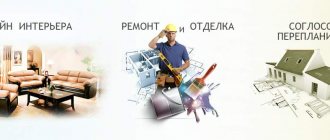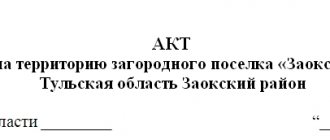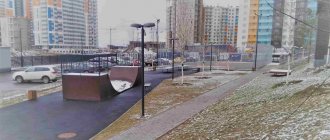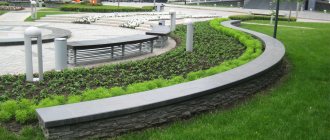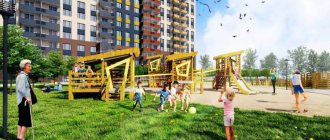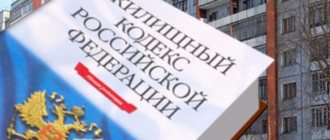The list of works and services for major repairs of common property in an apartment building is given in the following documents:
- Housing Code of the Russian Federation FZ-188 - part 1 (clause 1) of article 166 of chapter 15 of section IX
- Resolution of the State Construction Committee dated September 27, 2003 No. 170 “On approval of the Rules and Standards for the technical operation of the housing stock” - Appendix 8
- VSN 58-88 “Regulations on the organization and conduct of reconstruction, repair and maintenance of buildings, municipal and socio-cultural facilities” - in Appendix 9
- MDS81-35.2004 “Methodology for determining the cost of construction products on the territory of the Russian Federation” - clause 3.8
Let us present these points of these regulatory documents.
According to Appendix 8 of Gosstroy Resolution No. 170 of September 27, 2003:
Appendix No. 8 (recommended)
SAMPLE LIST OF WORK PERFORMED DURING CAPITAL REPAIRS OF HOUSING STOCK
1. Inspection of residential buildings (including a complete inspection of the housing stock) and preparation of design estimates (regardless of the period of repair work).
2. Repair and construction work to replace, restore or replace elements of residential buildings (except for the complete replacement of stone and concrete foundations, load-bearing walls and frames).
3. Modernization of residential buildings during their major renovation (redevelopment taking into account the disaggregation of multi-room apartments; installation of additional kitchens and sanitary units, expansion of living space due to auxiliary premises, improvement of insolation of residential premises, elimination of dark kitchens and entrances to apartments through kitchens with devices, with necessary, built-in or attached premises for staircases, sanitary facilities or kitchens); replacement of stove heating with central heating with the installation of boiler rooms, heat pipelines and heating points; rooftop and other autonomous heat supply sources; refurbishment of furnaces to burn gas or coal; equipment with cold and hot water supply systems, sewerage, gas supply with connection to existing main networks at a distance from the input to the connection point to the main lines up to 150 m, installation of gas ducts, water pumps, boiler rooms; complete replacement of existing central heating systems, hot and cold water supply (including the mandatory use of modernized heating devices and pipelines made of plastic, metal-plastic, etc. and a ban on the installation of steel pipes); installation of household electric stoves instead of gas stoves or kitchen fires; installation of elevators, garbage chutes, pneumatic garbage removal systems in houses with a landing of the upper floor of 15 m and above; transfer of the existing power supply network to higher voltage; repair of television antennas for collective use, connection to telephone and radio broadcasting networks; installation of intercoms, electric locks, installation of automatic fire protection and smoke removal systems; automation and dispatching of elevators, heating boiler houses, heating networks, engineering equipment; improvement of courtyard areas (paving, asphalting, landscaping, installation of fences, wood sheds, equipment of children's and utility areas). Repair of roofs, facades, joints of prefabricated buildings up to 50%.
4. Insulation of residential buildings (work to improve the heat-insulating properties of enclosing structures, installation of triple-glazed window fillings, installation of external vestibules).
5. Replacement of intra-block utility networks.
6. Installation of meters for metering thermal energy consumption for heating and hot water supply, cold and hot water consumption for the building, as well as installation of apartment meters for hot and cold water (when replacing networks).
7. Reconstruction of unventilated combined roofs.
8. Design supervision of design organizations for major repairs of residential buildings with full or partial replacement of floors and redevelopment.
9. Technical supervision in cases where local government bodies and organizations have created units for technical supervision of major repairs of housing stock.
10. Repair of built-in premises in buildings.
What does the capital repair fund do in Russia?
The fund is responsible for accumulating contributions for major repairs, which are paid by the owners of residential premises of each apartment building. Its funds can be directed only to certain purposes, the list of which is determined by the Housing Code.
Major expenses include:
- Repairing engineering systems, including supplying the house with heat, gas, water and electricity;
- Maintaining elevator equipment and shafts in proper condition;
- Reconstruction of roofs and facades;
- Ensuring the integrity of the foundation of the house.
Such a list is open, so the full list is determined at the regional level. Residents of the house have the right to independently determine the method of managing their own home, the option of forming a fund, and, consequently, the direction of spending funds.
The calculation of contribution amounts is characterized by the following features:
- the minimum size is established by acts of the subjects;
- Indexation is carried out annually taking into account the official consumer price index;
- do not depend on the number of persons currently living in the apartment.
The amount of the contribution directly depends on the characteristics of the building and influencing factors include the year of construction, the number of floors and the type of materials used in the construction when using such differentiation in the region. The overhaul program is formed for a certain period, which is necessary to carry out such work in relation to the full list of apartment buildings in a particular region. The document is subject to updating, which is carried out annually.
According to Appendix 9 of VSN 58-88:
APPENDIX 9 Recommended
List of additional work performed during major repairs of buildings and facilities
1. Inspection of buildings (including a comprehensive survey of the housing stock) and preparation of design estimates (regardless of the period of repair work).
2. Redevelopment of apartments that does not cause a change in the main technical and economic indicators of the building, an increase in the quantity and quality of services, equipment in apartments, kitchens and sanitary facilities; expansion of living space due to utility rooms; improvement of insolation of residential premises; elimination of dark kitchens and entrances to apartments through kitchens with the installation, if necessary, of built-in or attached premises for staircases, sanitary facilities or kitchens, as well as balconies, loggias and bay windows; replacement of stove heating with central heating with the installation of boiler rooms, heat pipelines and heating points; refurbishment of furnaces to burn gas or coal; equipment with cold and hot water supply, sewerage, gas supply systems with connection to existing main networks at a distance from the input to the connection point to the mains up to 150 mm; installation of gas ducts, water pumps, boiler rooms; installation of household electric stoves instead of gas stoves or kitchen fires; installation of elevators, garbage chutes, pneumatic garbage removal systems in houses with an upper floor landing level of 14 m and above; transfer of the existing power supply network to higher voltage; installation of television and radio antennas for collective use, connection to telephone and radio broadcast networks; installation of intercoms, electric locks; installation of automatic fire protection and smoke removal systems; automation and dispatching of heating boiler houses, heating networks, heating points and engineering equipment of residential buildings; improvement of courtyard areas (paving, asphalting, landscaping, installation of fences, wood sheds); equipment for children's, sports (except stadiums) and utility areas; dismantling of emergency houses; changing the roof structure; equipment of attic premises of residential and non-residential buildings for use.
3. Replacement of existing and installation of new technological equipment in buildings for communal and socio-cultural purposes.
4. Insulation and noise protection of buildings.
5. Replacement of worn-out elements of intra-block engineering networks.
6. Repair of built-in premises in buildings.
7. Examination of design and estimate documentation.
8. Design supervision of design organizations.
9. Technical supervision.
10. Carrying out repair and restoration work on monuments under state protection.
Program schedule until 2044
You can view the schedule for major renovations of a house at an address in Moscow not only for the coming years. A regional program for the overhaul of common property in Moscow apartment buildings until 2044 has already been developed. The information is freely available on the website repair.mos.ru.
According to clause 3.8 of MDS81-35.2004:
clause 3.8. Major repairs of buildings and structures include work to restore or replace individual parts of buildings (structures) or entire structures, parts and engineering equipment due to their physical wear and tear with more durable and economical ones that improve their performance.
Major repairs of external utilities and improvement facilities include repairs of water supply, sewerage, heat and gas and electricity networks, landscaping of courtyard areas, repair of paths, driveways and sidewalks, etc.
Preventive (current) repairs consist of systematically and timely work carried out to prevent wear of structures, finishing, engineering equipment, as well as work to eliminate minor damage and malfunctions.
Major and current repairs (concept and differences)
List of works for current repairs of an apartment building
Lists for the coming years
The main source of knowledge for residents of high-rise buildings should be the portal of the Moscow Apartment Buildings Overhaul Fund at fond.mos.ru. On the main page of the resource, there is a side menu on the left, where you should select the “Short-term capital repair plan” item.
This section contains a list of constantly updated documents with a schedule for major renovations of houses in Moscow until 2021. The user needs to select a document at the top of the list with the specification “Current edition”. The list itself will open on a new page, divided into several parts.
All documents are opened in PDF format and are presented in a table containing:
- exact address (including county and municipality);
- year of construction;
- square;
- year the overhaul began;
- list of events to be held;
- where the payment is transferred from.
Reference! The list is constantly updated due to the completion of repair work. Most buildings need to fix almost all communications at once, so the overhaul program is progressing rather slowly.
To pay fees or not
Legislative changes regarding the payment of contributions for major repairs have been in effect for several years, but disputes about the need to make them still continue. The current rules say that apartment owners are required to pay receipts. In some regions, bills for major repairs come as a separate payment, in others they are included in the general rent document.
Failure to pay on time may result in penalties, and long-term debt may result in legal proceedings. The latter in most cases occurs when a debt of several thousand accumulates. Based on the consideration of the case and the decision made, a writ of execution is formed, which is subsequently transferred to the bailiffs. They have a whole arsenal of debt collection tools at their disposal. These include seizure of a bank account, a ban on traveling abroad and a number of other methods.
There are exceptions when contributions for major repairs are allowed to be waived. Key situations include:
- Absence of the house in the list of participants in the regional overhaul program;
- Availability of a special benefit established by current legislation;
- Identification of a calculation error and recognition as such by the organization responsible for calculating contributions.
If an error is detected in calculating the amount of the contribution, the owner must send a statement to the organization that is responsible for generating accounts. Copies of receipts must be attached to the document to confirm the fact of timely payment.
If there are obstacles and it is impossible to resolve the issue peacefully, a citizen has the right to contact the housing inspectorate, whose powers include monitoring the correctness of the accruals made. In the absence of a proper response from the organization, the conflict is resolved through the use of a judicial mechanism.
To receive benefits for reducing the contribution to the capital repair fund, a citizen must confirm his right to use this opportunity. To do this, you need to collect the necessary package of documents, submit it to the MFC or the social security authority, choosing the method of submission in person, through a representative, or by sending it by registered mail.
The list of beneficiaries is limited and the list is determined by law. Persons over 80 years of age are exempt from full payment, and 70-year-old citizens and disabled people of groups 1 and 2 have the right to expect to pay only 50% of the contribution. Homeowners have the right to expect a reduction in the amount of the contribution and only within the established limits on the area of the premises per person.
Special account
The possibility of creating a special account is stipulated in the Law “On Amendments to Article 75 of the Law of the City of Moscow. It allows co-owners of the house to accumulate funds for major repairs in a separate account. Each account must be opened exclusively for 1 house.
Opening a special account will be convenient for owners if they are ready to:
- make a contribution of at least 18.19 rubles. for 1 sq. m.;
- determine the list of works during major repairs;
- take responsibility for managing the Fund's funds;
- find contractors to carry out work;
- determine how accruals will be made and receipts will be delivered;
- interact with debtors.
How can you change the method of forming the FCR and when?
If the owners decide to withdraw their funds from the RO and want to place them in a special account, they need to:
- Make such a decision at the general meeting with 2/3 votes.
- Send a copy of the Minutes to the RO within 5 days after the meeting.
- Over the next two years, funds will continue to accumulate with the operator, while the owners should not have debt to contractors for work performed or banks for loans issued for major repairs.
If the owners decide to transfer funds from the special fund to the management of the RO, such a decision must also be secured by the Protocol. Unlike the first option, this one comes into force 30 days after the general meeting.
A change in the method of accumulating FCR may be caused by the need to save money for owners or the ability to control the expenditure of accumulated contributions.

